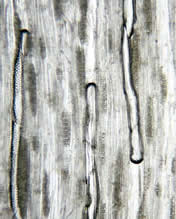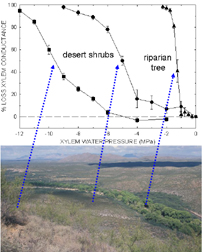Sperry Lab
Why do some plants grow where they do when others cannot? How does plant structure influence their physiology and adaptation to their environment? How has plant form and function evolved? These are some of the general questions that we address in our research. We focus these questions by concentrating on the fundamental carbon-for-water trade-off that confronts all terrestrial plants. Photosynthesis requires the plant surface to be porous to CO2 diffusion, but at the cost of also being porous to evaporative water loss. Mining the soil for water and piping it to the leaves involves elaborate root and branch systems, lots of complex vascular tissue, and a transport mechanism that teeters on the edge of physical possibility. Indeed, plant xylem has been called "the vulnerable pipeline" and a lot of our time is spent in discovering how the xylem works, and what happens when it doesn't. A specialty of the Sperry lab is the study of "cavitation," a rather spectacular failure of water transport that is caused by water stress or freezing. Some plants are more vulnerable to cavitation than others, and this turns out to be part of the answer to the question of why some plants grow where they do when others cannot.
(Above) Red Butte Canyon Research Natural Area as viewed from Little Black Mountain in the fall. This protected watershed is about 15 minutes from the University of Utah, and many Sperry lab projects have taken place here over the years.




